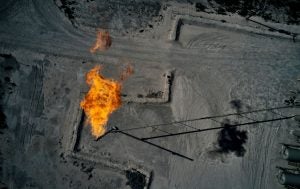 The final two months have seen encouraging momentum within the effort to sort out emissions of methane — a greenhouse gasoline that drives over 1 / 4 of present warming — and the observe of flaring, which is a serious supply of power waste and methane air pollution.
The final two months have seen encouraging momentum within the effort to sort out emissions of methane — a greenhouse gasoline that drives over 1 / 4 of present warming — and the observe of flaring, which is a serious supply of power waste and methane air pollution.
Beginning with final month’s Main Economies Discussion board, one of many final main local weather gatherings earlier than COP 27 in Egypt, signatories to the International Methane Pledge launched a brand new purpose to finish routine flaring as quickly as potential, and by 2030 on the newest.
Then, simply this week, the U.S. and Mexico introduced a dedication to cooperate and assist Mexico develop a plan to remove routine flaring in alignment with the International Methane Pledge.
Quick motion to finish routine flaring is important for decreasing emissions of methane, defending human well being and the local weather, and stopping useless waste of power assets because the world faces an power disaster spurred by Russia’s invasion of Ukraine.
Now, the U.S. has work to do to make sure home insurance policies can reside as much as our personal world commitments. Fortuitously, each the Bureau of Land Administration and the Environmental Safety Company have the authority and obligation to implement robust guidelines that finish routine flaring.
The flaring downside
The observe of routine flaring represents an unchecked supply of wasted assets and air pollution.
Research have proven that flaring is a serious supply of methane emissions, along with an array of different pollution that hurt human well being and degrade air high quality. Analysis carried out by EDF within the Permian Basin, the nation’s largest oilfield, repeatedly discovered that roughly 10% of flares are both malfunctioning or totally unlit. In consequence, these flares are spewing methane air pollution straight into the environment (see what that appears like right here).
As nations signal on to finish routine flaring, Biden admin should act Click on To Tweet
This air pollution has a direct affect on close by communities, and a current peer-reviewed research underscores that lots of the communities most impacted by oil and gasoline air pollution are traditionally marginalized.
Moreover, the observe of routine flaring is a serious supply of wasted power assets, with Vitality Data Administration knowledge indicating that the U.S. wastes roughly $1 billion of gasoline at flares annually. As customers cope with excessive power prices and Europe faces down an power disaster spurred by Russia’s invasion of Ukraine, stopping this waste represents a twin local weather and power safety win.
President Biden himself remarked that “local weather safety and power safety go hand in hand,” and added that “by stopping the leaking and flaring of the tremendous potent greenhouse gasoline and capturing this useful resource for international locations that want it, we’re addressing two issues without delay.”
In reality, EDF evaluation has proven that complete efforts to curb methane emissions and finish routine flaring within the U.S. alone might present over half of the gasoline the Biden administration has dedicated to Europe.
In the meantime, on public lands within the U.S., the place the Bureau of Land Administration is answerable for stewarding assets within the public’s curiosity, over $400 million of gasoline is flared off yearly. That interprets to $50 million in misplaced income that may in any other case go to supporting priorities like schooling and native infrastructure.
Coverage options
The excellent news is that each EPA and BLM are advancing guidelines with the potential to finish routine flaring. By rapidly enacting requirements that require commonsense options, these businesses can defend public well being, cease pointless power waste and safeguard each our local weather and power safety — all whereas dwelling as much as our world commitments.
Evaluation from Rystad Vitality has discovered that options for operators to deal with flaring and seize this in any other case wasted gasoline are each available and cost-effective, and in lots of circumstances even worthwhile.
It’s no surprise that we’ve seen an array of oil and gasoline operators commit to finish routine flaring. To call just a few: ExxonMobil has dedicated to finish routine flaring throughout its belongings within the Permian Basin by 2022, BP has dedicated to finish routine flaring by 2025 in its U.S. onshore operations, whereas many extra have signed on to the World Financial institution’s purpose of ending routine flaring worldwide by 2030.
The federal authorities must also look to the instance of main power producing states like Colorado and New Mexico, which have each moved to finish the observe of routine flaring and have demonstrated how sensible and achievable such motion will be.
EPA and BLM can and should construct on this instance to guard communities throughout the nation, put an finish to useless waste and uphold our world commitments as we urge different nations to do the identical.





0 Comments